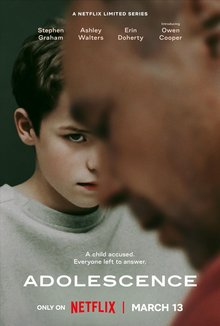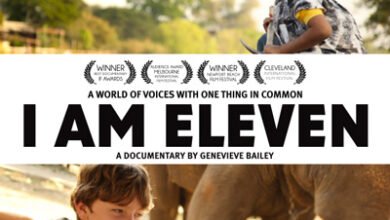A Comprehensive Review of the Netflix Series “Adolescence” From a Family Strengthening, Child Safeguarding & Protection, and Power Parenting Perspective
By Taiwo AKINLAMI & Safiya Hamza

Introduction
The Netflix limited series Adolescence has garnered significant global attention since its release on March 13, 2025. In just three weeks, it reached 96.7 million views, making it the ninth most-watched Netflix series to date.
The series has been reviewed extensively by leading media outlets. The Guardian described it as “the closest thing to TV perfection in decades,” praising its narrative depth and powerful performances. Forbes called it “an all-time technical masterpiece,” while Vulture listed it among “The Best TV Shows of 2025 (So Far),” commending its unique visual style and engaging plot.
Beyond critical acclaim, Adolescence has sparked meaningful conversations around the challenges today’s youth face, including bullying, social media influence, and emotional neglect. In response, British Prime Minister Keir Starmer announced that the series will be made freely available to all UK secondary schools via the educational streaming platform Into Film+. He described the series as one that “hit home hard,” particularly after watching it with his teenage children. The initiative aims to support discussions on misogyny, online radicalization, mental health, and healthy relationships in schools.
In Adolescence, we are invited into the delicate and often stormy journey of growing up, a time shaped by emotional vulnerability, self-discovery, and a yearning for both independence and belonging. This is especially relevant in today’s volatile and digitalized world, where the opportunities available to young people are vast, yet so too are the risks. In fact, it is because the opportunities are immense that the risks are equally high. The digital space holds incredible potential for learning, expression, and connection, but without proportional preparation, guidance, and safeguards, that same space can become a source of confusion, pressure, and harm. Rather than retreating in fear, Adolescence calls us, parents, caregivers, educators, and society at large, to rise in capacity, vigilance, and presence, equipping ourselves to walk alongside our precious children as they navigate the complexities of growing up in this new world.
Plot Overview
The story follows Jamie Miller, a 13-year-old boy who becomes entangled in a murder investigation following the death of his classmate, Katie Leonard. From the start, it is clear that Jamie’s actions are shaped by his exposure to harmful online ideologies.
Spending significant time in the digital space, Jamie stumbles upon the “manosphere” — an online subculture promoting toxic masculinity, dominance, and misogyny. These digital influences twist his perception of identity and manhood, drawing him into a dangerous worldview that ultimately leads to a violent act.
The film uses Jamie’s descent as a powerful lens through which to explore radicalization, peer pressure, emotional isolation, and the absence of adult support. His story is not simply one of personal failure, but a profound commentary on the failure of the systems meant to protect and guide him.
Family Strengthening Perspective
The film underlines the vital role of a functional, emotionally connected family in supporting adolescents through their formative years. While many of us may believe that providing food, shelter, and education is enough, Adolescence reminds us that emotional neglect can be just as damaging, and often, even more invisible.
When our precious children feel unseen or unheard in their own homes, they naturally begin to search for affirmation elsewhere and sometimes, in places that can cause harm. Jamie’s vulnerability in the film is shaped by this absence of emotional connection and guidance.
The movie also brings to light a common parenting challenge in today’s world: understanding and engaging with our children’s digital lives. Rather than simply supervising them, we are called to walk alongside them, not just to watch, but to support, to strengthen, and to grow with them.
Reflections on Family Strengthening
Here are a few shared commitments we can all consider as we work to build emotionally secure homes for our children:
- Let’s Stay Present in Our Children’s Digital Lives – It’s no longer enough to monitor from a distance. We can engage meaningfully, explore together, and guide them as they make informed choices online.
- Let’s Create Space for Open Conversations – Our homes should be safe spaces where children feel free to speak without fear of shame or rejection.
- Let’s Model Healthy Masculinity and Humanity – By embodying empathy, respect, and emotional honesty, we help our children unlearn harmful stereotypes and embrace healthier identities.
- Let’s Grow in Digital Literacy Together – As we learn about the digital world, we can teach our children how to think critically about what they consume and how it shapes them.
- Let’s Acknowledge the Pressures of Social Media – We can validate our children’s struggles while equipping them to build resilience and find worth beyond likes and comparisons.
- Let’s Pay Attention to Warning Signs – If we notice shifts in behavior, let’s respond with compassion and curiosity rather than fear or punishment.
- Let’s Emphasize Internal Self-Worth – We can remind our children daily that their value is rooted in who they are, not how the world responds to them.
- Let’s Strengthen Our Bonds Intentionally – Time, trust, and togetherness lay the foundation for influence. The more connected we are, the more protected our children feel.
Child Safeguarding & Protection Perspective
Adolescence offers a sobering view of what can happen when the emotional, psychological, and digital safety of our precious children is overlooked. Jamie’s story is not just a cautionary tale; it’s an invitation for us to reflect deeply on the systems we build around children and how well those systems truly protect them.
We see how emotional distress, peer pressure, and online manipulation can quietly escalate when no one is paying close enough attention. The series reminds us that safeguarding isn’t a one-time action, it’s a continuous posture of presence, listening, and action.
Reflections on Safeguarding and Protection
As we consider our role, whether as parents, caregivers, educators, or advocates, here are some thoughts we might hold close:
- Let’s Be Attuned to Emotional and Psychological Well-Being – Sometimes, the deepest wounds aren’t visible. When children face bullying, exclusion, or overwhelming stress, they often send subtle signals. We can choose to notice and respond early, offering safety through empathy and consistent care.
- Let’s Broaden Our Understanding of Neglect – Safeguarding isn’t just about physical protection. When a child’s emotional needs go unmet, they may feel just as endangered. Our presence, attention, and encouragement matter deeply.
- Let’s Create Environments That Resist Bullying – In our homes, schools, and communities, we can actively foster cultures of kindness and accountability. Teaching our precious children how to stand up for themselves and others, and showing them how to seek help, is part of how we protect them.
- Let’s Walk with Them in the Digital World – As children navigate online spaces, they need more than rules, they need guidance. We can be conversation partners in their digital journeys, discussing risks like cyberbullying and helping them build courage and clarity when things go wrong.
By making these choices together, gently, intentionally, and consistently, we help build a safer world for every child.
Power Parenting Perspective
At the heart of Adolescence is not just a gripping story, it’s a call. A call for purposeful parenting, not perfect parenting. Jamie’s life begins to unravel not because of a single moment, but because the adults around him did not lead with purpose, model stability, or equip him to make wise choices.
His story reminds us that our precious children don’t simply need supervision, they need support, structure, and someone walking the journey with them. This is where the Power Parenting framework meets us, not as a rulebook, but as a mindset, a shared commitment, and a way forward.
At the foundation of Power Parenting lies one transformational belief:
The best way to retain power is to give it, by preparing our precious children to stand strong with wisdom, resilience, and confidence.
We also recognize that parenting goes beyond biology. Anyone who influences a child’s life, consistently, compassionately, and consciously, holds the sacred role of a parent.
The Four Cardinal Principles of Power Parenting
- Purpose – Let’s parent with the end in mind. Our goal isn’t just to correct behavior in the moment, but to raise emotionally grounded, responsible adults who can navigate life with strength and compassion.
- Capacity Building – We are learning too. As we grow in knowledge (what to do), skills (how to do it), and fortitude (the strength to keep going), we become the kind of adults our children can lean on, learn from, and trust.
- Application (Wisdom) – It’s not enough to know; we must live it. Wisdom shows up in our daily choices, in how we listen, guide, affirm, and correct. It’s about doing what’s right in our children’s best interests, even when it’s not convenient or easy.
- Modeling – Our children may not always follow our advice, but they will mirror our lives. As we embody empathy, respect, and integrity, we leave footprints they can follow. Our children are either beneficiaries or casualties of our example.
While not listed as a core principle, protection and empowerment are essential outcomes of Power Parenting. We don’t parent to control, we parent to prepare, to protect, and to empower. Because when children are truly equipped, they don’t just avoid danger, they rise in confidence and character.
Together, We Can…
Power Parenting calls on all of us – parents, caregivers, mentors, and educators – to move away from reactive, fear-based parenting, and toward a model rooted in vision, strength, and trust. It invites us to trade perfection for presence, and authority for influence.
It reminds us that we’re not just raising our precious children to follow the rules. We’re raising them to lead with values. To recognize their worth. To understand their voice. To make informed, meaningful choices.
In Jamie’s world, these principles were painfully absent. No one parented with vision, modeled healthy values, or helped him build the capacity he needed to navigate the pressures of adolescence. Even love, if it existed, lacked the structure to be protective.
But Adolescence offers more than a warning, it offers a possibility. It reminds us that when we parent with purpose, build capacity, apply wisdom, and model strength, our precious children don’t just survive, they lead
Conclusion
Adolescence is more than a compelling drama; it is a collective wake-up call. It invites us, not just as parents, but as caregivers, educators, mentors, and community members, to move beyond rule-setting into a space of intentional connection, emotional presence, and proactive care.
The series lays bare the silent battles many children are fighting, and it reminds us of the high cost of our silence, our assumptions, or our inattention.
For all of us who share the privilege of influencing a child’s life, one vital question quietly echoes:
Are we raising children who feel safe, heard, and valued, or are we, unknowingly, leaving them to face dangers alone?
The way we answer, in word and in action, will shape not just their present, but their future. And perhaps, as we rise to that responsibility together, we might just help them rise too.
Do have an INSPIRED weekend with the family.





